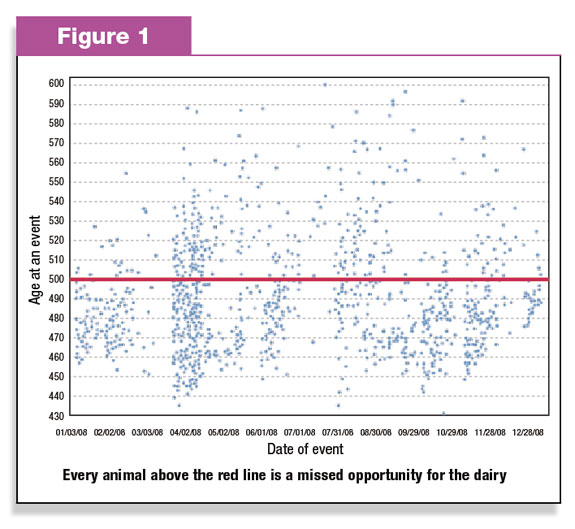Are you interested in making an extra $60 per heifer? What kind of difference would that make to your bottom line? Many dairies I work with have the opportunity to reduce heifer-raising costs by at least $60 per head. On some operations, potential savings is even higher. Dairies that routinely achieve pregnancy rates of 20 percent or higher in the milking herd often find their heifers are calving for the first time at 25 months old or later. That extra month beyond the recommended 24 months at first calving adds around $60 in feed costs alone, in addition to other costs associated with housing, labor and so forth.
If you think your heifer reproductive program is functioning well, you may want to look again. Many of the metrics commonly used to assess a heifer breeding program don’t provide a clear picture of what’s really going on.
Looking at the wrong measurements?
Many dairies do a great job of managing lactating herd reproduction by using the standard 21-day pregnancy rate. Unfortunately, they don’t use this metric in their heifer breeding programs.
The most commonly used measurements of heifer reproduction are conception rate and percentage of heifers pregnant within three services. While these metrics drive the number of heifers in the calving pipeline, they don’t indicate how long it takes for heifers to get there.
Time is the missing component from most heifer reproduction management programs. Since gestation length is fixed, age at first breeding is the biggest driver of reproductive efficiency in heifer programs.
For the 50 percent of heifers that don’t conceive on the first insemination, age at second breeding will be the biggest driver – and so on as services increase.

Scatter plots showing age at first insemination for all heifers, like the one in Figure 1 , are good ways to assess if heifers are being bred for the first time soon enough after the voluntary waiting period.
Set a goal for age at first insemination and see how many heifers meet it. Additional important metrics are pregnancy rate, heat detection rate and conception rate.
Five easy steps
Manage heifer breeding pens more aggressively if your program isn’t measuring up. Compliance with the voluntary waiting period is key to improved performance. Put systems in place to ensure first breeding is completed in a timely manner.
Heifers have higher fertility than lactating cows, so even a modest effort to improve their performance will pay off more quickly than in the milking herd. Here’s how you can take simple steps to get heifers bred more quickly.
1. Move heifers to the breeding pen. Move heifers into the artificial insemination (A.I.) breeding pen as soon as they reach height and weight targets. On most dairies, this should be done on a weekly basis.
Breeders do a good job of inseminating heifers, but too often, heifers are moved only once a month or even less frequently. This results in slugs of breeding rather than a consistent supply of eligible open heifers. Don’t delay moving heifers based on age. If heifers are big enough, move them into the breeding pen.
2. Administer prostaglandin on date of move. Weekly pen moves will provide breeders with open heifers eligible to breed on a regular basis.
Administering a prostaglandin (PGF2α) product on the date of move will ensure they come into heat soon after they arrive. Using PGF2α up-front can save 10 to 12 days of feed in the breeding pen alone.
3. Make sure all heifers are inseminated. A follow-up injection of PGF2α should be given 11 to 14 days after move for any heifers that haven’t yet been inseminated. A multi-state research project found that treatment of dairy heifers with PGF2α every 14 days until insemination and pregnancy resulted in the best economic outcomes when compared with other synchronization protocols or doing nothing at all.
A controlled internal drug release (CIDR) cattle insert can be used for timed breeding on heifers not inseminated during their first 28 days in the breeding pen. This will help ensure all heifers are inseminated within 36 days of arrival into the A.I. pen.
4. Routine pregnancy checks. Conduct pregnancy diagnosis as routinely as heifers are moved to the breeding pen in order to identify pregnant females.
Size of the pen is often a limiting factor for heifer breeding, so it’s critical to move pregnant females out of the breeding pen to make room for open ones. All pregnancies should be reconfirmed at 70 to 90 days carried calf.
5. Re-enroll open heifers. Immediately submit any heifers diagnosed open to a timed breeding program with PGF2α or CIDR.
A five-day CIDR-synch protocol (CIDR insert for five days, PGF2α injection at CIDR removal followed by GnRH and breeding 72 hours after CIDR removal) has helped some dairies improve heifer pregnancy rates. Monitor performance on an ongoing basis and track progress after each pregnancy check.
Managing heifer reproduction as intensely as the lactating herd can pay real dividends. The incremental costs are minimal compared with the benefits of heifers spending less time in the bred heifer pen and more time in the milking string.
It’s simple and it pays
Heifer reproduction is an overlooked profit opportunity on many dairies. Fortunately, improving heifer reproduction is a simple process with the potential for quick return.
It takes commitment to aggressively manage heifer breeding and provide your A.I. breeders with heifers in heat ready to breed. This commitment can positively impact your reproductive program’s success and your dairy’s bottom line. PD
References omitted due to space but are available upon request to editor@progressivedairy.com .
Genomics offer more opportunity
Before the introduction of more economical options, genomic testing was practical only for elite genetic breeders and A.I. companies. Now with the availability of the 3K chip, commercial application of genomics offers new ways to increase the influence of genetically superior females in the herd.
Heifers represent the best genetics in most herds, so it’s logical to focus on this group for genomic testing. Dairies that have accurate sire and dam identification for heifers should sort them by predicted transmitting ability (PTA) and test the top 10 to 15 percent.
Those heifers identified as genetically superior are great candidates for more advanced reproductive programs, such as embryo transfer or sexed semen, to extend their genetic influence within the herd.
Likewise, the bottom 10 to 15 percent can be candidates for embryo recipients or even sold prior to calving. This prevents genetically inferior heifers from contributing to the future genetic pool of the herd.
Keep in mind that genetically superior individuals won’t always be the highest type or production cows in the herd. Both type and production are impacted by environment, disease incidence, nutrition and other factors besides genetics.
Across an entire herd, genetically superior females are more likely to perform better than their herdmates, but exceptions will exist. Increasing their influence in your herd’s makeup can offer long-term benefits.
Dr. John Lee
Senior Veterinarian
Pfizer Animal Health
john_lee2@pfizer.com






